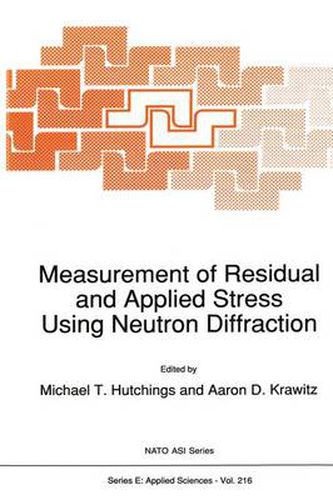Readings Newsletter
Become a Readings Member to make your shopping experience even easier.
Sign in or sign up for free!
You’re not far away from qualifying for FREE standard shipping within Australia
You’ve qualified for FREE standard shipping within Australia
The cart is loading…






This title is printed to order. This book may have been self-published. If so, we cannot guarantee the quality of the content. In the main most books will have gone through the editing process however some may not. We therefore suggest that you be aware of this before ordering this book. If in doubt check either the author or publisher’s details as we are unable to accept any returns unless they are faulty. Please contact us if you have any questions.
The accurate, absolute, and non-destructive measurement of residual stress fields within metallic, ceramic, and composite engineering components has been one of the major problems facing engineers for many years, and so the extension of X-ray methods to the use of neutrons represents a major advance. The technique utilizes the unique penetrating power of the neutron into most engineering materials, combined with the sensitivity of diffraction, to measure the separation of lattice planes within grains of polycrystalline engineering materials, thus providing an internal strain gauge. The strain is then converted to stress using calibrated elastic constants. It was just over ten years ago that the initial neutron diffraction measurements of residual stress were carried out, and during the ensuing decade measurements have commenced at most steady state reactors and pulsed sources around the world. So swift has been the development of the field that, in addition to fundamental scientific studies, commercial measurements have been made on industrial components for several years now. The use of neutrons is ideally suited to the determination of triaxial macrostress tensors, macrostress gradients, and microstresses in composites and multiphase alloys as well as deformed, plastically anisotropic metals and alloys. To date, it has been used to investigate welded and heat-treated industrial components, to characterize composites, to study the response of material under applied loads, to calibrate more portable methods such as ultrasonics, and to verify computer modelling calculations of residual and applied stress.
$9.00 standard shipping within Australia
FREE standard shipping within Australia for orders over $100.00
Express & International shipping calculated at checkout
Stock availability can be subject to change without notice. We recommend calling the shop or contacting our online team to check availability of low stock items. Please see our Shopping Online page for more details.
This title is printed to order. This book may have been self-published. If so, we cannot guarantee the quality of the content. In the main most books will have gone through the editing process however some may not. We therefore suggest that you be aware of this before ordering this book. If in doubt check either the author or publisher’s details as we are unable to accept any returns unless they are faulty. Please contact us if you have any questions.
The accurate, absolute, and non-destructive measurement of residual stress fields within metallic, ceramic, and composite engineering components has been one of the major problems facing engineers for many years, and so the extension of X-ray methods to the use of neutrons represents a major advance. The technique utilizes the unique penetrating power of the neutron into most engineering materials, combined with the sensitivity of diffraction, to measure the separation of lattice planes within grains of polycrystalline engineering materials, thus providing an internal strain gauge. The strain is then converted to stress using calibrated elastic constants. It was just over ten years ago that the initial neutron diffraction measurements of residual stress were carried out, and during the ensuing decade measurements have commenced at most steady state reactors and pulsed sources around the world. So swift has been the development of the field that, in addition to fundamental scientific studies, commercial measurements have been made on industrial components for several years now. The use of neutrons is ideally suited to the determination of triaxial macrostress tensors, macrostress gradients, and microstresses in composites and multiphase alloys as well as deformed, plastically anisotropic metals and alloys. To date, it has been used to investigate welded and heat-treated industrial components, to characterize composites, to study the response of material under applied loads, to calibrate more portable methods such as ultrasonics, and to verify computer modelling calculations of residual and applied stress.